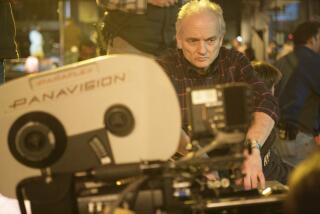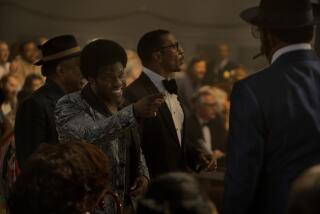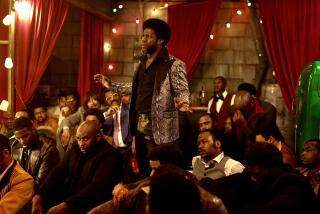âGangsterâ gets a shot
The upcoming movie, âAmerican Gangster,â is a gripping real-life story about a Harlem drug kingpin who in the â70s smuggled heroin out of Southeast Asia in the caskets of U.S. soldiers killed in Vietnam.
The plot is dense, with lots of twists and turns.
So is the saga of the movieâs three lives.
Fraught with emotional trauma, crushed egos, humiliation and passion, the movieâs tortured journey to the big screen was unusual even by Hollywood standards. The project was killed off twice by Universal Pictures when the budget soared out of control, then resurrected three years later, at a much higher cost. Seven years in the making, âAmerican Gangsterâ premieres Nov. 2., with such headliners as producer Brian Grazer, director Ridley Scott, and stars Denzel Washington and Russell Crowe. It weighs in at $100 million, with worldwide marketing likely to add $80 million to the cost, not to mention the $30 million Universal spent to shut down the original production.
In an age when bean counters and focus groups drive movie decisions, the film is the type of highflier reminiscent of Hollywoodâs past, when studio bosses such as Louis B. Mayer trusted their gut.
âUniversalâs decision to make this movie defies any kind of logic of how the studio system works today,â said Grazer, the Oscar-winning producer behind âAmerican Gangster.â
Grazerâs ability to revive the movie also shows the power that a handful of top producers have in Hollywood. Itâs hard for studios to say ânoâ to people such as Grazer, whose company, Imagine Entertainment, is Universalâs most prolific movie supplier.
âBrian is a great producer. He put this project back together in an irresistible way,â Universal Studios President Ron Meyer said. âGiven the scope of the film and the excellence of the cast, the director, the script and the production qualities, we think itâs a very sound investment.â
The movieâs connection with gangster rap could help it bring in young viewers. Rapper Jay-Z released an album titled âAmerican Gangsterâ as a companion to the movieâs soundtrack that was inspired by scenes from the film.
âThe hip-hop generation reveres the gangster culture -- you see it in the lyrics of songs, fashion, style and cultural choices,â Universal Pictures Chairman Marc Shmuger said.
Careening out of control
âAmerican Gangsterâsâ long road to the silver screen began with author-screenwriter Nick Pileggi, whose book âWiseguysâ was the basis for Martin Scorseseâs enduring 1990 gangster classic âGoodfellas.â It was through Pileggi, an executive producer on the film, that Grazer met the real-life characters depicted in âAmerican Gangsterâ: Frank Lucas, a semiliterate guy from North Carolina who came to New York and hustled his way to becoming Harlemâs drug king. Richie Roberts is the tough New York detective bent on bringing him down.
Pileggi, a seasoned crime writer who had worked for New York magazine, knew Lucas when the gangster was behind bars. In 2000, Pileggi introduced him to reporter Mark Jacobson, who wrote a profile of Lucas in New York magazine.
Pileggi and Jacobson tried to sell the movie rights to Hollywood but no one bit until Grazer became enthralled after his first meeting with Pileggi, Lucas, Richie and Jacobson. The producer suggested hiring Oscar-winning screenwriter Steven Zaillian (âSchindlerâs Listâ), who after talking through the story with Pileggi and meeting Lucas and Richie, agreed to write a 22-page treatment and later a full-length script.
In its original incarnation, âAmerican Gangsterâ was to be a joyous reunion of âTraining Dayâ director Antoine Fuqua and his Oscar-winning star, Washington. Benecio Del Toro, who won an Academy Award for his supporting role in the 2001 drug crime drama âTraffic,â was to portray the cop, Roberts.
Production was to begin in November 2004. But as the date approached, Universal executives began to fret. The filmâs $85-million budget was careening out of control. Scenes were being cut, then added back in, making it impossible for Universal to get a âlocked script.â The budget would easily soar past $100 million once production was underway.
In a meeting with Fuqua in New York, Stacey Snider, who at the time was chairwoman of Universal Pictures, and two of her top executives could not rectify the ballooning budget. With cameras set to roll in New York in just a few weeks, Snider and her boss, Meyer, made a rare decision so late in the game: They pulled the plug, opting to cut their losses rather than risk even greater disaster down the road.
âEverybody had a map of how to get the budget down, but nobody was following the map,â recalled Snider, who dreaded having to shut down the movie.
âIt was one of the hardest decisions I ever made,â said Snider, who left Universal in February 2006 to head DreamWorks SKG.
The movie was canceled, but Universal was contractually on the hook to pay Washington his $20-million fee and Del Toro, $5 million. The studio also doled out $5 million in other pre-production costs, paying off the contracts of the cinematographer, production designer and others. Universal lost $30 million with nothing to show for it.
A painful experience
The loss cut deep.
âEverybody thinks theyâre making a movie and are ready to start, then suddenly theyâre all going home and packing up all the stuff,â Grazer recalled. âWe had hired every department head. The extras were cast and fitted for wardrobe. We had floors in a building with thousands of changes of clothes for the actors. We had locked locations and had all the props to make it viable to shoot.â
Fuqua was devastated: âIt goes without saying that the experience was painful.â
Grazer was embarrassed when he heard from Washingtonâs agent that the movie had been canceled, his first and only film ever to be shut down.
âIt was such a failure. I donât like costing people money,â he said. Over the last two decades, Grazer has produced 58 movies -- 40 of them for Universal -- with his production partner, director Ron Howard, including the Oscar-winning hit âA Beautiful Mind.â
After a week of feeling defeated, Grazer decided to call Washington. âI said, âLook, this is really uncomfortable, but if I can figure out a way of reapproaching this will you stay involved?â he said he asked. Washington told him yes.
Five months later, in March 2005, Grazer approached âHotel Rwandaâ writer-director Terry George about taking a less ambitious approach to the movie and bringing the budget down to about $50 million. George cut some key scenes, characters and one major location -- Thailand -- to reduce costs.
But after a few months, Grazer and the studio decided it wasnât working.
âIt was still a financial conundrum,â Snider said.
Grazer thought the storyâs integrity had been compromised. âIt excluded too many good scenes, characters and locations. We couldnât make it right.â
A higher-caliber crew
Months passed. Grazer decided it was time to swing for the fences. He made a play for one of the most sought-after directors, Ridley Scott (âBlade Runner,â âThelma and Louise,â âHannibal.â) He hadnât been available when Grazer had informally pitched him the idea in the past. Scott was set to direct âInvisible Worldâ for Paramount Pictures but when the star, Angelina Jolie, got pregnant, the production was canceled.
After Scott signed on to direct âAmerican Gangsterâ in November 2005, Grazer re-recruited Washington and both of them wooed Crowe to co-star. The actor had worked with Grazer on âA Beautiful Mindâ and the less successful âCinderella Man.â Crowe had collaborated with Scott on the Oscar hit âGladiatorâ and on the dud âA Good Year.â Grazer wanted to rehire Zaillian but said he felt guilty about the radical overhaul of his original script by George.
âYou start a movie, it doesnât get made, you start it again and cut out all the guyâs great scenes,â Grazer said. âI called and apologized to Steve and said âIâm sorry this happened.â â
Zaillian was won over.
Now all Grazer needed was Universalâs money to make the movie with this higher-caliber crew. Snider was heading out the door to DreamWorks, so Grazer approached her successor, Shmuger, the studioâs former marketing chief.
Grazer proposed a budget of $100 million, due largely to the higher fees commanded by Scott and Crowe over Fuqua and Del Toro.
Universal was already $30 million in the hole, and expensive dramas such as âAmerican Gangsterâ are the riskiest bets Hollywood can take. Without eye-popping special effects, comic book heroes or big laughs, these films donât much interest young audiences, appealing largely to adult moviegoers, who are harder to get into seats.
Yet Americans of all ages have long loved crime dramas. From James Cagney and Edward G. Robinson pictures of the 1930s and â40s to more contemporary classics such as âGodfather,â âGoodfellasâ and âScarface,â American moviegoers have had a fascination with criminals. This yearâs best picture Oscar-winner, âThe Departed,â was a violent gangster drama starring Jack Nicholson, Leonardo DiCaprio and Matt Damon. HBOâs mafia series, âThe Sopranos,â was must-see TV.
On May 12, the film was approved for production with the provision that if it cost more than $100 million, Grazer and Scott would pay the overage. They each forked over about $1.5 million after the film wrapped.
Now all Grazer and Universal need is for moviegoers everywhere to open their pocketbooks.
--
--
(BEGIN TEXT OF INFOBOX)
Flicks to die for
Some memorable gangster movies (with their domestic gross):
1 âThe Godfatherâ
1972, Paramount
$135 million
--
2 âThe Departedâ
2006, Warner Bros.
$132.4 million
--
âThe Untouchablesâ
1987, Paramount
$76.3 million
--
âThe Godfather: Part IIIâ
1990, Paramount
$66.7 million
--
âThe Godfather: Part IIâ
1974, Paramount
$47.5 million
--
3 âGoodfellasâ
1990, Warner Bros.
$46.8 million
--
4 âScarfaceâ
1983, Universal
$44.7 million
--
âCasinoâ
1995, Universal
$42.5 million
--
Source: Media by Numbers
More to Read
Only good movies
Get the Indie Focus newsletter, Mark Olsen's weekly guide to the world of cinema.
You may occasionally receive promotional content from the Los Angeles Times.










